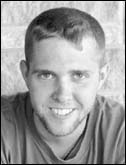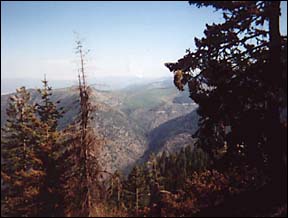 Ainsley flew to Missoula, Mont., on Aug. 11, his 21st birthday. The U.S. Forest Service assisted the Montana Department of Natural Resources and Conservation (DNRC).
Ainsley flew to Missoula, Mont., on Aug. 11, his 21st birthday. The U.S. Forest Service assisted the Montana Department of Natural Resources and Conservation (DNRC).  Sam Ainsley's summer working for the United States Forest Service started with maintenance in the Boundary Waters Canoe Area in northern Minnesota and ended with him fighting wildfires in Montana for two weeks.
Sam Ainsley's summer working for the United States Forest Service started with maintenance in the Boundary Waters Canoe Area in northern Minnesota and ended with him fighting wildfires in Montana for two weeks.Ainsley took the picture at right in which the smoke from the fire at Ryan Gulch can be seem on the far horizon.
Ainsley, who now attends Vermillion Community College in Ely after graduating from Paynesville Area High School in 1998, started as a wilderness ranger with the forest service in June. Wilderness rangers make maintenance trips into the BWCA to trim and clear trails and repair campsites. In crews of two to eight people, they would spend eight days in the wilderness working.
In light of the massive wind damage at the BWCA last summer, a concern was that a massive fire could start with all the downed trees and branches.
Ainsley took a class on wilderness fire fighting at Vermillion last December. He passed a physical test in June to be certified to fight fires, the designation is a red card. "I wanted to get red carded so if a fire happened in the BWCA or anywhere else, I could do it," said Ainsley of his interest in fire fighting training.
Significant forest fires never materialized in the BWCA this year, due to the amount of rain the area received, Ainsley said. "It rained every day in June but two days," he explained. "
Hardly ideal weather to be on canoe trips repairing trails and campsites, but perfect for reducing fire risk. "The BWCA this year was a rain forest," Ainsley said.
With the fire risk in northern Minnesota reduced by the weather, wilderness fire fighting crews were sent out west, which had one of the worst fire seasons on record.
In July, Ainsley was moved to the fire crew to compensate for personnel who had gone west. He responded to two fires in the BWCA. Both were unextinguished camp fires, and both had burnt a small area and burnt out by the time Ainsley and his crew arrived. They just mopped up the area, checking for any smoldering hot spots and dousing them with water.
Two weeks in Montana
 Ainsley flew to Missoula, Mont., on Aug. 11, his 21st birthday. The U.S. Forest Service assisted the Montana Department of Natural Resources and Conservation (DNRC).
Ainsley flew to Missoula, Mont., on Aug. 11, his 21st birthday. The U.S. Forest Service assisted the Montana Department of Natural Resources and Conservation (DNRC).
Ainsley's first impression of Missoula was that someone must have moved Los Angeles to the mountains. The smoke was worse than smog. "All the smoke from all the fires got trapped in the valley," he explained. "Some days you could only see about a quarter of a mile. It was pretty bad."
Ainsley worked on an engine crew with his supervisor from Ely. They drove an F450 pick-up truck that had a hose on both sides of the truck and could carry 300 gallons of water. The truck was from Minnesota, too, and was being loaned to help fight the fires in Montana.
Engine crews patrolled the area around Missoula. Some days they were on-call to respond quickly to any new fire. Other days they would mop up burnt areas.
When he arrived in Montana, Ainsley worked for 36 hours straight. A new, 60-acre fire had broke out. While helicopters dropped water and retardant on the blaze, Ainsley and a crew of 20 men cleared a landing area on an adjacent mountain. The pad was needed to bring in ground crews to fight the fire the next day.
Ainsley's crew had to cut the trees flat to the ground and move the trees off the landing area by hand. "That was exhausting," he said. "You can really feel it when you are high up."
The blaze on the adjacent mountain included about 60 acres. "That's pretty big for out here in Minnesota. Actually, in a normal fire year, that's pretty big for out there, but this year it was nothing. That's because there's been so much fire."
Ainsley did not fight the massive, 20,000-acre fires shown on television. His crew stayed within 30 miles of Missoula for the entire two weeks he was in Montana. From there, though, he could see the column of smoke from the Ryan Gulch fire 30 miles away.
Ainsley's crew split time between on-call and mop-up duty. In two weeks, Ainsley averaged 14 hours of work per day. He worked over 200 hours in two weeks.
On-call duty had the benefit of waiting by the Black Foot River for a new fire. That river was the setting for the fly fishing in the movie, A River Runs Through It.
Ainsley and his crew had a popular park on the river all to themselves. Because of the fire danger, the governor of Montana ordered people to stay indoors for a time. People were not allowed outside on either public or private property because starting a car could start a fire. "It was just so dry," Ainsley explained.
Ainsley did have time for a couple of tourist stops before flying home. One highlight for him was the wildlife. He saw big horn sheep and mule deer. His crew mates saw a mountain lion jump between two trucks while driving in the mountains, but Ainsley was in the lead vehicle and missed seeing it.
With his experience for this summer, Ainsley wants to get a job on a hand crew next summer. These crews dig fire lines to try to contain large blazes and do the initial attack on the fires.
Ainsley, the son of Pastor Keith and Beatty Ainsley of Paynesville, is finishing up his course work at Vermillion this fall before transferring to Bemidji State University. He is majoring in wilderness management and thinks one day he would like to prepare Environmental Assess-ment Worksheets.